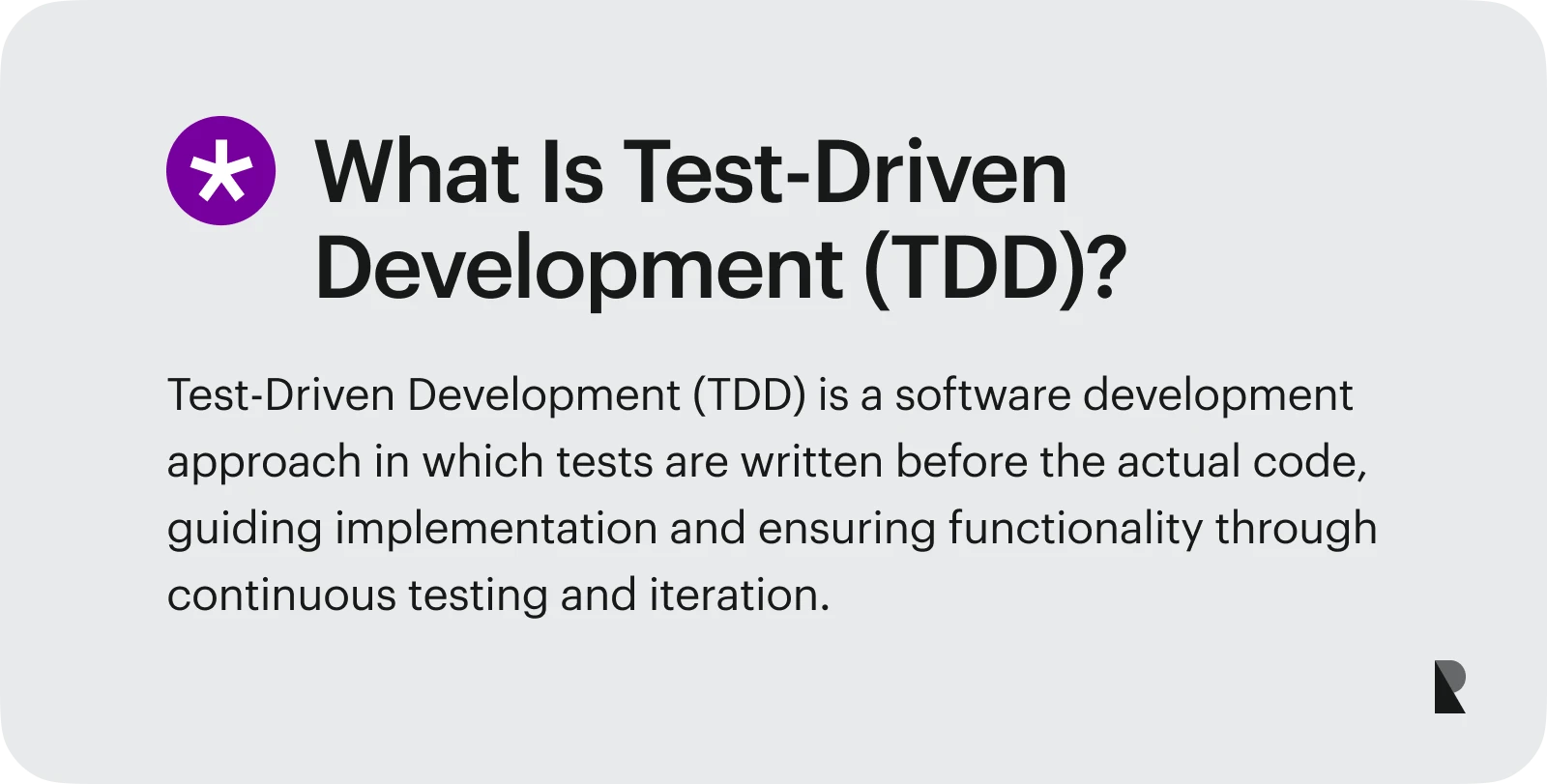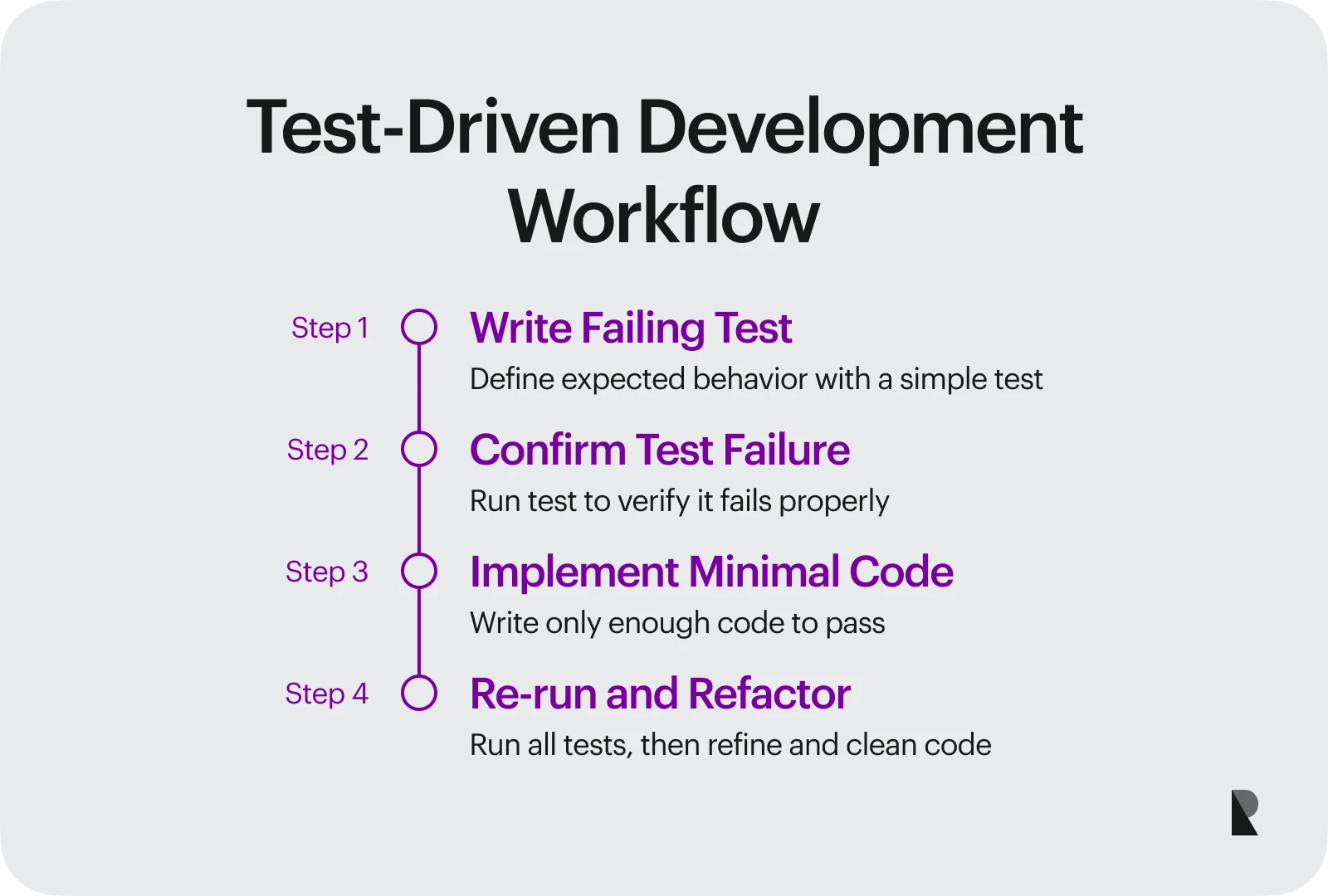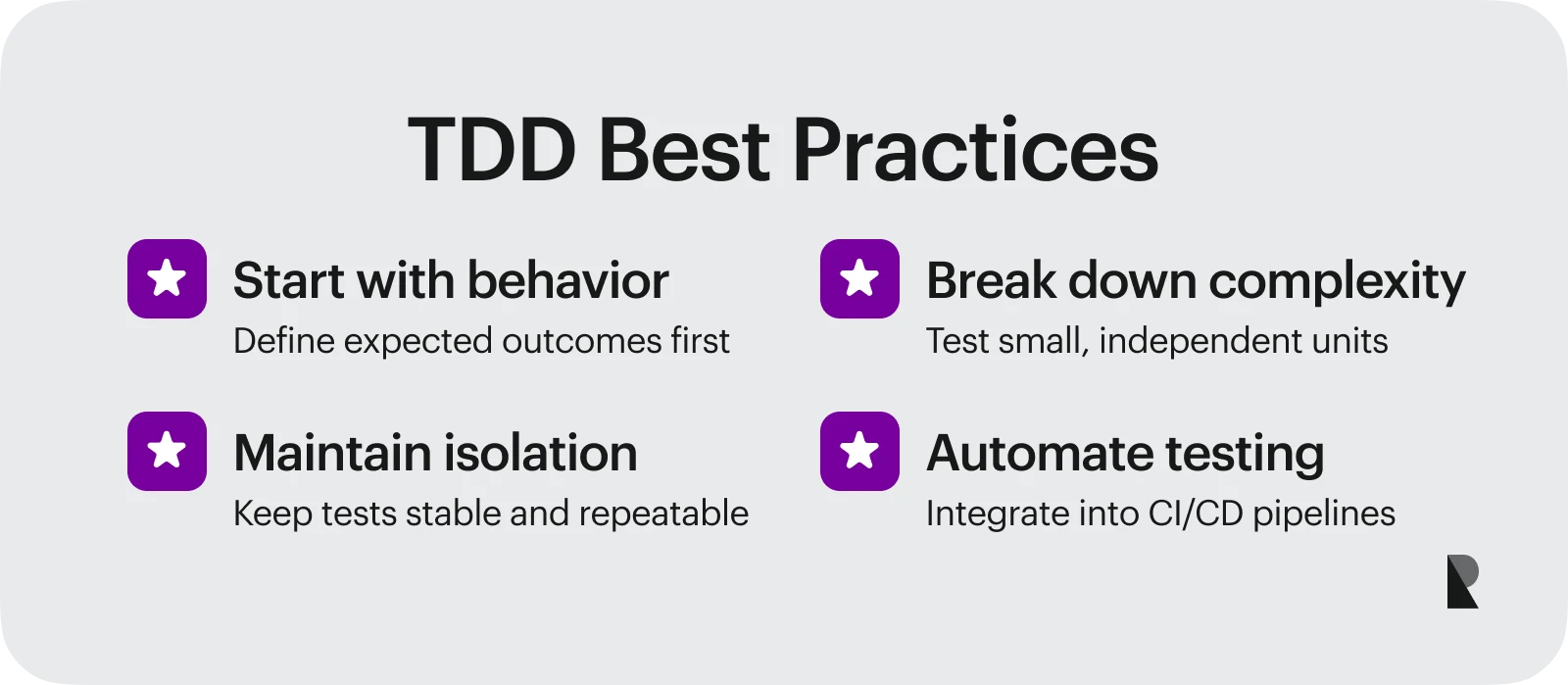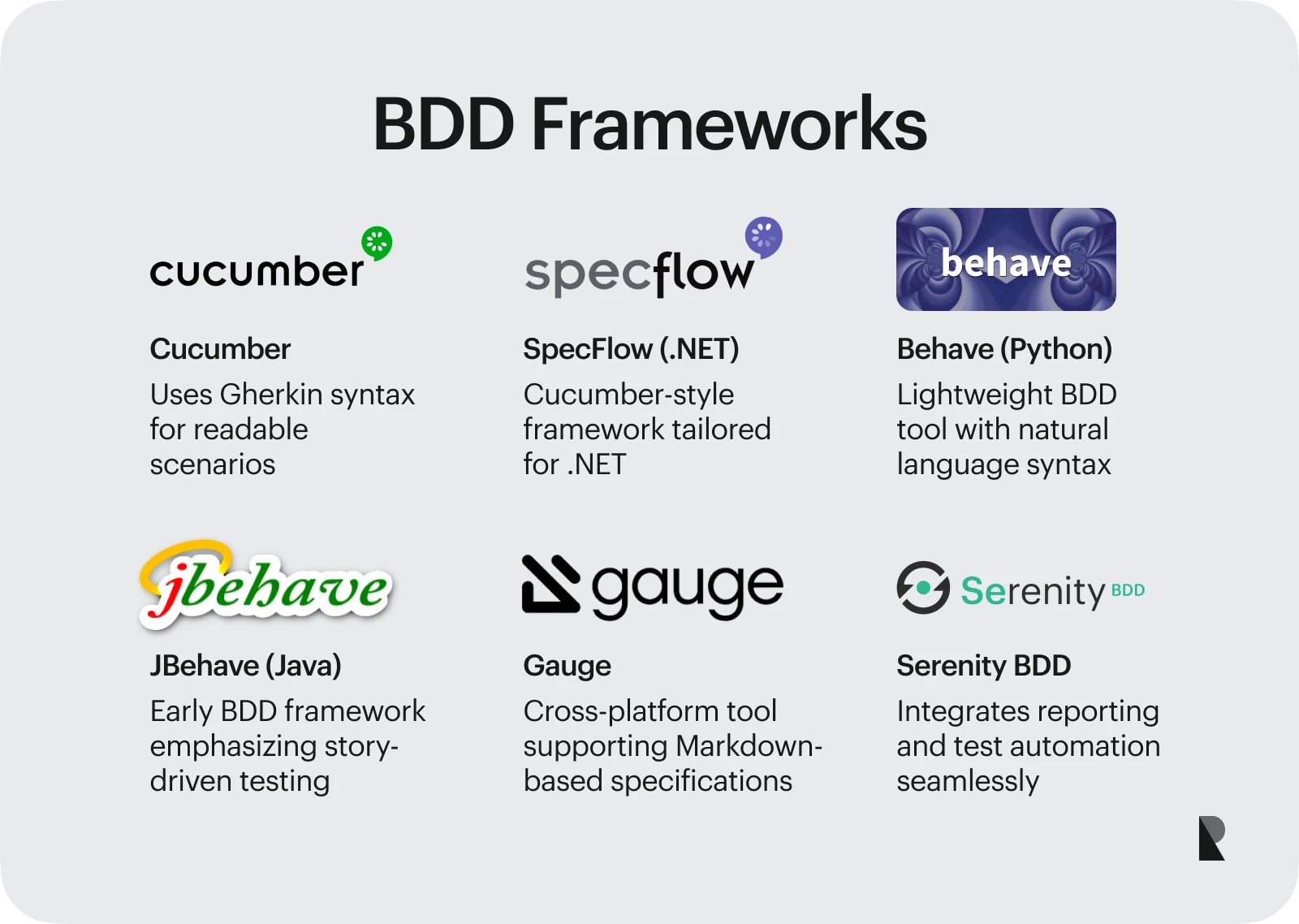
Test-Driven Development (TDD) vs Behavior-Driven Development (BDD) represents one of the most essential choices for modern development teams. In today's rapidly evolving software landscape, TDD has become the default approach for Agile software development over the past several years.
However, many app development companies are now exploring BDD, which is often misunderstood but is actually just the evolution of test-driven development.
When it comes to understanding the difference between TDD and BDD, it's essential to recognize their distinct focuses. While TDD concentrates on writing automated tests before writing the actual code that needs to be tested, BDD takes a broader approach by emphasizing collaboration between stakeholders to define and validate system behaviors.
In companies with a TDD policy, developers don't have to fear show-stopping bugs slipping into production, since quality checks occur well before code implementation.
Similarly, BDD ensures that most use cases of the application work on a higher level and provide a greater level of confidence. In fact, the top application development firms often combine elements from each approach, and many teams strengthen this practice by collaborating with a web app development software company to align testing workflows with broader product objectives.
In this guide, we'll break down what TDD and BDD are, how they differ, and most importantly, how to determine which testing approach best fits your team's needs in 2025 and beyond.
What Is Test-Driven Development (TDD)?
Unlike traditional software development, where code comes first and tests follow, Test-Driven Development (TDD) completely reverses this process. Pioneered by Kent Beck in the late 1990s as part of Extreme Programming, TDD has established itself as a fundamental practice in agile software development.
At its core, TDD is a methodology that requires developers to write automated tests before writing any production code. This approach uses short development cycles that help verify both the quality and correctness of code.
The essence of TDD follows a simple yet powerful formula: TDD = Test-First Development + Refactoring.
Many developers initially perceive this backward-sounding approach as counterintuitive. Nevertheless, this method produces cleaner, more durable code that's less prone to breaking over time.
TDD focuses primarily on unit tests that cover small portions of logic, such as individual algorithms or functions. These tests should be deterministic, meaning they shouldn't have side effects such as calls to external APIs delivering random or changing data.
How To Practice Test-Driven Development?
Mastering Test-Driven Development requires following a structured workflow that centers around writing tests first. The TDD approach follows a specific set of steps that form a repeating cycle, ensuring code quality throughout the development process.

Write the initial failing test
First, we need to understand what we're trying to build and write a test that defines the expected behavior or outcome. This test should be small, focused, and verify just one aspect of functionality. During this stage, we write the simplest test possible that expresses the requirement, even though it will fail because the implementation doesn't exist yet.
Run the test to confirm failure
Next, we run the test to verify it fails as expected. This step might seem obvious, yet it's crucial; if the test passes without any implementation code, either the test is incorrect or the functionality already exists elsewhere. The failing test confirms we're actually testing something meaningful and establishes a baseline for development.
Implement minimal code to pass the test
Subsequently, we write just enough production code to make the failing test pass, nothing more. The emphasis here is on "minimal" implementation, even if the solution seems incomplete or inelegant. This approach prevents over-engineering and keeps the focus on meeting defined requirements rather than speculating about future needs.
Run all tests and refactor
After implementing the code, we rerun all tests to ensure the new code passes the test without breaking existing functionality. Assuming success, we can now refactor both the implementation and test code to improve quality while maintaining the same behavior. This includes removing duplication, improving naming, and enhancing readability.
The Red–green–refactor cycle explained
The entire process above represents the "Red–Green–Refactor" cycle that sits at the heart of TDD:
- Red: Write a failing test that describes a new feature or identifies a bug
- Green: Implement the minimal code needed to pass that test
- Refactor: Clean up the code while ensuring all tests still pass
Test-Driven Development in Action

To see how the theory of TDD translates into practical implementation, let's examine actual code examples and real-world applications. Understanding these concrete examples will clarify the differences between TDD and BDD approaches.
Simple unit test example
Consider a simple Python calculator example that demonstrates the TDD cycle in action:
# Step 1: Write a failing testimport unittestfrom calculator import add class TestCalculator(unittest.TestCase): def test_add(self): self.assertEqual(add(2, 3), 5) if __name__ == "__main__": unittest.main()At this stage, the test fails because the add function doesn't exist yet. Next, we write just enough code to make the test pass:
# Step 2: Implement minimal code to pass the testdef add(a, b): return a + bOnce the test passes, we can refactor for better handling:
# Step 3: Refactor while keeping tests greendef add(a, b): return int(a) + int(b)This example illustrates the core TDD principle: each feature starts with a failing test that drives the minimal implementation necessary.
Applying TDD in a real development workflow
In professional environments, TDD integrates with established development practices. The Apache Tomcat project, for instance, utilizes TDD extensively, writing tests before implementing new features. Likewise, JetBrains' IntelliJ IDEA development team attributes improved code quality and faster bug detection to their TDD practices.

At Microsoft, development teams implement a hybrid TDD approach where detailed requirements documents drive the test and development effort. They use various tools alongside TDD practices, including static analysis tools and dependency analysis tools to enhance quality.
For effective implementation in your workflow:
- Start with behavior: Focus on what functionality should accomplish rather than its structure
- Break down complexity: Divide large features into smaller, testable units
- Maintain test isolation: Ensure tests are deterministic and don't depend on external resources
- Use automation: Incorporate TDD tests into continuous integration pipelines
Through this disciplined approach, teams have reported up to 40% reduction in production defects and 60% decrease in deployment time when TDD is properly integrated into their CI/CD pipeline.
Defining Behavior-Driven Development (BDD)

Behavior-Driven Development (BDD) emerged as an extension of Test-Driven Development around 2006, primarily through Dan North's work to address common challenges teams faced with TDD implementation. Instead of focusing solely on technical aspects, BDD shifts attention toward business outcomes and user experiences.
At its essence, BDD is a collaborative approach that encourages conversation between business stakeholders, QA professionals, and developers to formulate a shared understanding of how the software should behave from the user's perspective.
This methodology bridges the gap between technical and non-technical team members by using a common language that everyone can understand and comprehend.
The core philosophy of BDD centers around three main principles:
- Defining application behavior using examples in conversation
- Documenting these examples in a ubiquitous language understood by all stakeholders
- Automating these examples to provide quick feedback
What truly sets BDD apart is its emphasis on creating executable specifications written in natural language. These specifications typically follow a Given-When-Then format, describing preconditions, actions, and expected outcomes in plain English or another human-readable language.
Beyond technical validation, BDD serves as a communication tool that aligns teams around business goals and user needs. By describing behavior before implementation, teams can verify they're building the right features that deliver actual business value.
How To Practice Behavior-Driven Development

Implementing Behavior-Driven Development effectively requires a collaborative approach that bridges the gap between technical and business teams. To begin, let's examine the structured workflow that enables BDD's success.
Write behavior scenarios using Gherkin Syntax
BDD implementation starts with collaboration among all stakeholders to define the system's expected behavior. First, identify the features that need development based on user expectations. Next, create feature files that document these behaviors using the Gherkin language. Finally, write scenarios that describe specific test cases to illustrate the expected outcomes.
Implement each scenario using TDD principles
Once scenarios are defined, implement them through these steps:
- Convert user stories into executable specifications
- Write step definitions connecting behaviors to actual code
- Develop functionality until all scenarios pass
- Use these passing scenarios as acceptance criteria
Understanding Gherkin Syntax (Given-When-Then)
Gherkin uses a structured format with specific keywords that create a common vocabulary everyone understands. The core pattern follows:
- Given: Sets up the initial context or preconditions
- When: Describes the action or event being tested
- Then: Specifies the expected outcomes
For example:
"Given I am logged in as administrator, When I navigate to the user management page, Then I should see a list of all users."This approach creates living documentation that evolves with the product, ensuring alignment between technical implementation and business objectives.
TDD vs. BDD: Key Differences and Comparison

Understanding the core distinctions between TDD and BDD is essential for choosing the proper testing approach for your development team. Both methodologies share common ancestry yet serve different purposes within the development ecosystem.
Focus: Functionality vs. Behavior
TDD primarily focuses on code functionality and implementation details, ensuring individual units work correctly through developer-written tests. In contrast, BDD concentrates on the overall system behavior from an end-user perspective, establishing a clear connection between technical development and business value.
Approach: Technical tests vs. Collaborative scenarios
TDD employs a technical approach centered around code-based tests written in programming languages. These tests verify specific functions or methods in isolation. Conversely, BDD adopts a collaborative approach using natural language scenarios that describe expected application behaviors understandable by all stakeholders.
Participants: Developers vs. Cross-Functional teams
With TDD, developers typically work independently, writing tests and implementation code. BDD expands participation to include product owners, business analysts, QA specialists, and developers who collectively define requirements and acceptance criteria.
Documentation: Code vs. Natural language
TDD documentation exists primarily as code within test files, requiring technical knowledge to interpret. Alternatively, BDD creates living documentation through Gherkin-syntax feature files that serve as both specifications and tests, accessible to both technical and non-technical team members.
Workflow and communication style
TDD follows the Red-Green-Refactor cycle with minimal communication requirements beyond the development team. Meanwhile, BDD emphasizes continuous conversation among all stakeholders to ensure shared understanding of requirements throughout the development process.
How TDD and BDD complement each other
Remarkably, these approaches aren't mutually exclusive. Many teams implement "BDD on the outside, TDD on the inside", using BDD for high-level acceptance criteria and requirements definition, then applying TDD principles to implement the underlying code that satisfies those requirements.
Popular Frameworks for TDD

Selecting appropriate testing frameworks forms a crucial part of implementing Test-Driven Development successfully. The right tools enable developers to write better tests and maintain efficient TDD workflows across different programming languages.
JUnit
JUnit is the grandfather of TDD frameworks, having primarily served Java developers since 1997. This open-source framework provides annotations such as @Test, @Before, and @After, which simplify test organization. JUnit 6, the latest major version, introduces a modular architecture with separate components for different testing needs.
PyUnit (unittest)
Python developers practicing TDD typically turn to PyUnit, now known as the unittest module in Python's standard library. Inspired by JUnit, this framework requires no additional installation, making it accessible for immediate TDD adoption.
PyUnit organizes tests into test cases and test suites, following object-oriented principles. Notably, its setUp() and tearDown() methods enable proper test isolation, a fundamental aspect of effective TDD implementation.
TestNG
TestNG emerged as an alternative to JUnit, specifically designed to address certain limitations in earlier versions of JUnit. Beyond basic unit testing capabilities, TestNG excels in integration testing with features such as dependent methods and group testing.
Its flexible annotation system provides greater control over test execution order, making it suitable for complex TDD scenarios where test dependencies are essential.
Popular Frameworks for BDD

BDD frameworks provide the essential tooling required to implement behavior-driven practices effectively across development teams. These specialized tools transform plain-language specifications into executable tests that validate the behavior of applications.
Cucumber
Cucumber stands out as the most widely adopted BDD framework in the market today. This open-source testing tool enables the writing of test scenarios in plain English using Gherkin syntax, making tests comprehensible regardless of the technical knowledge required.
Its popularity has grown steadily, doubling its user base every 18 months with over 40 million downloads. In 2017 alone, Cucumber was downloaded 20 million times across various language implementations.
Cucumber's architecture includes Feature Files containing Gherkin scenarios, Step Definitions that bind scenarios to code, and a Test Runner that executes the tests.
The framework supports multiple programming languages, including Java, Ruby, JavaScript, Python, PHP, Perl, Swift, .NET, and C++, making it adaptable for virtually any development environment.
SpecFlow
SpecFlow functions as the .NET counterpart in the Cucumber family, specifically designed for Microsoft's ecosystem. This open-source framework supports the .NET Framework, Xamarin, and Mono, and is coupled with excellent Visual Studio integration through available extensions.
Unlike other BDD tools, SpecFlow uses the official Gherkin parser and integrates seamlessly with popular .NET testing frameworks, including MSTest, NUnit, xUnit 2, and MbUnit.
Conclusion: Choosing Between TDD and BDD
Choosing between Test-Driven Development and Behavior-Driven Development ultimately depends on your team's specific needs and organizational structure. Throughout this guide, we've seen how TDD excels at ensuring code quality through developer-written tests that verify functionality at a technical level.
The differences between these methodologies extend beyond their technical aspects. TDD primarily engages developers working with code-based tests, whereas BDD involves cross-functional teams creating scenarios that connect technical implementation with business objectives.
Though presented as alternatives, these methodologies work best when combined thoughtfully. Many successful teams implement what experts call "BDD on the outside, TDD on the inside", using BDD to define high-level acceptance criteria and requirements, then applying TDD principles to implement the underlying code.
Ultimately, regardless of the testing approach chosen, the goal remains consistent: delivering high-quality software that meets user needs and business objectives.
Whether you embrace TDD, BDD, or a thoughtful combination of both, commitment to automated testing and quality-focused development practices will undoubtedly strengthen your software development process in 2025 and beyond.
Nov 4, 2025
